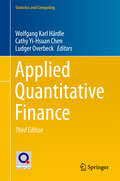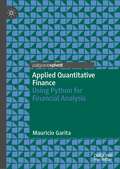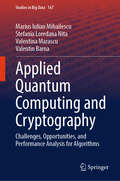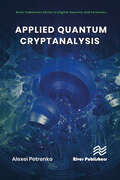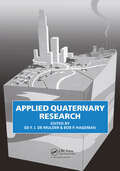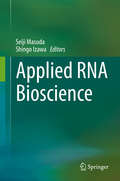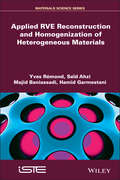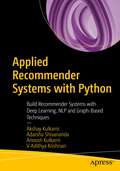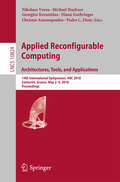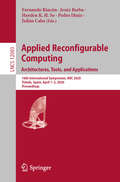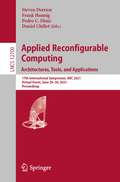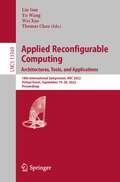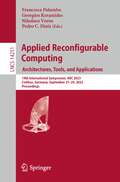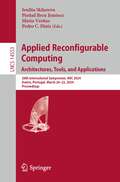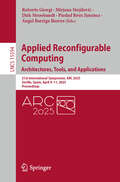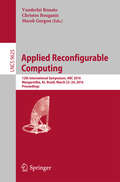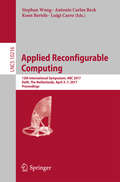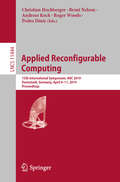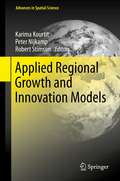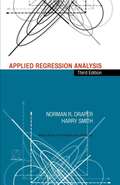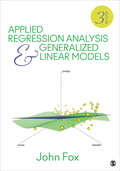- Table View
- List View
Applied Quantitative Finance (Statistics and Computing)
by Wolfgang Karl Härdle Cathy Yi-Hsuan Chen Ludger OverbeckThis volume provides practical solutions and introduces recent theoretical developments in risk management, pricing of credit derivatives, quantification of volatility and copula modeling. This third edition is devoted to modern risk analysis based on quantitative methods and textual analytics to meet the current challenges in banking and finance. It includes 14 new contributions and presents a comprehensive, state-of-the-art treatment of cutting-edge methods and topics, such as collateralized debt obligations, the high-frequency analysis of market liquidity, and realized volatility. The book is divided into three parts: Part 1 revisits important market risk issues, while Part 2 introduces novel concepts in credit risk and its management along with updated quantitative methods. The third part discusses the dynamics of risk management and includes risk analysis of energy markets and for cryptocurrencies. Digital assets, such as blockchain-based currencies, have become popular but are theoretically challenging when based on conventional methods. Among others, it introduces a modern text-mining method called dynamic topic modeling in detail and applies it to the message board of Bitcoins. The unique synthesis of theory and practice supported by computational tools is reflected not only in the selection of topics, but also in the fine balance of scientific contributions on practical implementation and theoretical concepts. This link between theory and practice offers theoreticians insights into considerations of applicability and, vice versa, provides practitioners convenient access to new techniques in quantitative finance. Hence the book will appeal both to researchers, including master and PhD students, and practitioners, such as financial engineers. The results presented in the book are fully reproducible and all quantlets needed for calculations are provided on an accompanying website. The Quantlet platform quantlet. de, quantlet. com, quantlet. org is an integrated QuantNet environment consisting of different types of statistics-related documents and program codes. Its goal is to promote reproducibility and offer a platform for sharing validated knowledge native to the social web. QuantNet and the corresponding Data-Driven Documents-based visualization allows readers to reproduce the tables, pictures and calculations inside this Springer book.
Applied Quantitative Finance: Using Python for Financial Analysis
by Mauricio GaritaThis book provides both conceptual knowledge of quantitative finance and a hands-on approach to using Python. It begins with a description of concepts prior to the application of Python with the purpose of understanding how to compute and interpret results. This book offers practical applications in the field of finance concerning Python, a language that is more and more relevant in the financial arena due to big data. This will lead to a better understanding of finance as it gives a descriptive process for students, academics and practitioners.
Applied Quantum Computing and Cryptography: Challenges, Opportunities, and Performance Analysis for Algorithms (Studies in Big Data #167)
by Stefania Loredana Nita Marius Iulian Mihailescu Valentina Marascu Valentin BarnaThis book explores the dynamically developing areas of quantum computing and quantum cryptography. The book offers an in-depth examination of the possibilities and difficulties presented by these revolutionary technologies, with the goal of connecting abstract ideas with real-world applications. The book is an extremely helpful resource in the context of the upcoming quantum age. This highlights the importance of creating cryptographic techniques that can withstand the power of quantum computers to protect digital communications and vital infrastructures. This work makes a substantial contribution to the topic of cybersecurity by doing a comprehensive analysis of classical and quantum cryptography approaches, as well as actual implementations and performance evaluations. The book plays a vital role in providing valuable guidance to researchers, practitioners, and policymakers. It offers valuable insights that are necessary for effectively managing the shift towards quantum-secure technology and safeguarding the future security of digital information.
Applied Quantum Cryptanalysis
by Alexei PetrenkoToday we witness an explosive growth in attention to Q-computing. Q-computing technologies, along with artificial intelligence (AI) and machine learning (ML) technologies, cloud and foggy computing, as well as technologies for collecting and streaming processing of Big Data and ETL, are constantly leading the lists of ""end-to-end"" information technologies for the digital economy of technologically developed countries of the world. One of the main reasons for this is the potential ability of quantum computers to solve some computational problems more efficiently than any of the most modern classical computers of the von Neumann architecture (supercomputers). The most expressive and interesting, from an applied point of view, examples of such problems are integer factorization, effectively performed by Shor's quantum algorithm, as well as record search in an unordered database, effectively solved by Grover's algorithm. This monograph contains the best practice for solving problems of quantum cryptanalysis to improve cyber security and resilience of the digital economy. The book discusses well-known and author's software implementations of promising quantum Shor algorithms, Grover, Simon et al. Shor's algorithm provides exponential acceleration of solving factorization problems, discrete logarithm problems (DLPs) and elliptic curve discrete logarithm problems (ECDLPs). The mentioned tasks are widely used in TLS, SSH or IPsec cryptographic applications of Internet/Intranet and IIoT/IoT networks, communication protocols based on Diffie–Hellman key agreements (dependent on the strength of the DLP or ECDLP), digital signature algorithms (DSA, ECDSA, RSA-PSS), public key encryption algorithms (El Gamal, RSA-OAEP), etc. In other words, Shor's quantum algorithm is potentially capable of violating these algorithms, and with them all the mechanisms of public-key cryptography deployed in cyberspace.
Applied Quaternary Research
by ED F.J.DE MULDER Bob P. HagemanProceedings of a symposium at the 1987 INQUA Congress, Ottawa, Aug. 1987. Contributions present the application of quaternary studies to land use planning and development. No index. Annotation copyright Book News, Inc. Portland, Or.
Applied RNA Bioscience
by Seiji Masuda Shingo IzawaThe focus of this book is to introduce up-to-date information on applications and practical use of RNA for agriculture, biotechnology and medicine.<P><P> It provides unique ideas, tools, and methods in detail from a variety of scientific and technical disciplines. RNA science has progressed enormously in recent decades, and vast amounts of information on RNA functions and their regulatory mechanisms are becoming available. Such a progress opened the door to an age of practical application of RNA in many fields including agriculture, plant science, medical science, brewing and fermentation technology, and material production. <P>This book inspires its readership and contributes to not only expansion in application of RNA but also to basic research.
Applied RVE Reconstruction and Homogenization of Heterogeneous Materials
by Majid Baniassadi Hamid Garmestani Yves Rémond Said AhziStatistical correlation functions are a well-known class of statistical descriptors that can be used to describe the morphology and the microstructure-properties relationship. A comprehensive study has been performed for the use of these correlation functions for the reconstruction and homogenization in nano-composite materials. Correlation functions are measured from different techniques such as microscopy (SEM or TEM), small angle X-ray scattering (SAXS) and can be generated through Monte Carlo simulations. In this book, different experimental techniques such as SAXS and image processing are presented, which are used to measure two-point correlation function correlation for multi-phase polymer composites. Higher order correlation functions must be calculated or measured to increase the precision of the statistical continuum approach. To achieve this aim, a new approximation methodology is utilized to obtain N-point correlation functions for multiphase heterogeneous materials. The two-point functions measured by different techniques have been exploited to reconstruct the microstructure of heterogeneous media. Statistical continuum theory is used to predict the effective thermal conductivity and elastic modulus of polymer composites. N-point probability functions as statistical descriptors of inclusions have been exploited to solve strong contrast homogenization for effective thermal conductivity and elastic modulus properties of heterogeneous materials. Finally, reconstructed microstructure is used to calculate effective properties and damage modeling of heterogeneous materials.
Applied Radiological Anatomy
by Jeremiah C. Healy Paul Butler Adam W. M. MitchellThis expanded new, full colour edition of the classic Applied Radiological Anatomy is an exhaustive yet practical imaging resource of every organ system using all diagnostic modalities. Every illustration has been replaced, providing the most accurate and up-to-date radiographic scans available. Features of the second edition: * Completely new radiographic images throughout, giving the best possible anatomic examples currently available * Both normal anatomy and normal variants shown * Numerous colour line illustrations of key anatomy to aid interpretation of scans * Concise text and numerous bullet-lists enhance the images and enable quick assimilation of key anatomic features * Every imaging modality included Edited and written by a team of radiologists with a wealth of diagnostic experience and teaching expertise, and lavishly illustrated with over 1,000 completely new, state-of-the-art images, Applied Radiological Anatomy, second edition, is an essential purchase for radiologists at any stage of their career.
Applied Recommender Systems with Python: Build Recommender Systems with Deep Learning, NLP and Graph-Based Techniques
by Akshay Kulkarni Adarsha Shivananda Anoosh Kulkarni V Adithya KrishnanThis book will teach you how to build recommender systems with machine learning algorithms using Python. Recommender systems have become an essential part of every internet-based business today. You'll start by learning basic concepts of recommender systems, with an overview of different types of recommender engines and how they function. Next, you will see how to build recommender systems with traditional algorithms such as market basket analysis and content- and knowledge-based recommender systems with NLP. The authors then demonstrate techniques such as collaborative filtering using matrix factorization and hybrid recommender systems that incorporate both content-based and collaborative filtering techniques. This is followed by a tutorial on building machine learning-based recommender systems using clustering and classification algorithms like K-means and random forest. The last chapters cover NLP, deep learning, and graph-based techniques to build a recommender engine. Each chapter includes data preparation, multiple ways to evaluate and optimize the recommender systems, supporting examples, and illustrations. By the end of this book, you will understand and be able to build recommender systems with various tools and techniques with machine learning, deep learning, and graph-based algorithms.What You Will LearnUnderstand and implement different recommender systems techniques with PythonEmploy popular methods like content- and knowledge-based, collaborative filtering, market basket analysis, and matrix factorization Build hybrid recommender systems that incorporate both content-based and collaborative filteringLeverage machine learning, NLP, and deep learning for building recommender systems Who This Book Is ForData scientists, machine learning engineers, and Python programmers interested in building and implementing recommender systems to solve problems.
Applied Reconfigurable Computing. Architectures, Tools, and Applications: 14th International Symposium, Arc 2018, Santorini, Greece, May 2-4, 2018, Proceedings (Lecture Notes In Computer Science #10824)
by Pedro C. Diniz Diana Goehringer Michael Huebner Nikolaos Voros Georgios Keramidas Christos AntonopoulosThis book constitutes the proceedings of the 14th International Conference on Applied Reconfigurable Computing, ARC 2018, held in Santorini, Greece, in May 2018. <P><P> The 29 full papers and 22 short presented in this volume were carefully reviewed and selected from 78 submissions. In addition, the volume contains 9 contributions from research projects. The papers were organized in topical sections named: machine learning and neural networks; FPGA-based design and CGRA optimizations; applications and surveys; fault-tolerance, security and communication architectures; reconfigurable and adaptive architectures; design methods and fast prototyping; FPGA-based design and applications; and special session: research projects.
Applied Reconfigurable Computing. Architectures, Tools, and Applications: 16th International Symposium, ARC 2020, Toledo, Spain, April 1–3, 2020, Proceedings (Lecture Notes in Computer Science #12083)
by Pedro Diniz Fernando Rincón Jesús Barba Hayden K. H. So Julián CabaThis book constitutes the proceedings of the 16th International Symposium on Applied Reconfigurable Computing, ARC 2020, held in Toledo, Spain, in April 2020. The 18 full papers and 11 poster presentations presented in this volume were carefully reviewed and selected from 40 submissions. The papers are organized in the following topical sections: design methods & tools; design space exploration & estimation techniques; high-level synthesis; architectures; applications.
Applied Reconfigurable Computing. Architectures, Tools, and Applications: 17th International Symposium, ARC 2021, Virtual Event, June 29–30, 2021, Proceedings (Lecture Notes in Computer Science #12700)
by Pedro C. Diniz Frank Hannig Steven Derrien Daniel ChilletThis book constitutes the proceedings of the 17th International Symposium on Applied Reconfigurable Computing, ARC 2021, held as a virtual event, in June 2021. The 14 full papers and 11 short presentations presented in this volume were carefully reviewed and selected from 40 submissions. The papers cover a broad spectrum of applications of reconfigurable computing, from driving assistance, data and graph processing acceleration, computer security to the societal relevant topic of supporting early diagnosis of Covid infectious conditions.
Applied Reconfigurable Computing. Architectures, Tools, and Applications: 18th International Symposium, ARC 2022, Virtual Event, September 19–20, 2022, Proceedings (Lecture Notes in Computer Science #13569)
by Yu Wang Wei Xue Lin Gan Thomas ChauThis book constitutes the proceedings of the 18th International Symposium on Applied Reconfigurable Computing, ARC 2022, held as a virtual event, in September 2022. The 13 full papers presented in this volume were reviewed and selected from 16 submissions. The papers cover a broad spectrum of applications of reconfigurable computing, from driving assistance, data and graph processing acceleration, computer security to the societal relevant topic of supporting early diagnosis of Covid infectious conditions.
Applied Reconfigurable Computing. Architectures, Tools, and Applications: 19th International Symposium, ARC 2023, Cottbus, Germany, September 27–29, 2023, Proceedings (Lecture Notes in Computer Science #14251)
by Pedro C. Diniz Nikolaos Voros Georgios Keramidas Francesca PalumboThis book constitutes the proceedings of the 19th International Symposium on Applied Reconfigurable Computing, ARC 2023, which was held in Cottbus, Germany, in September 2023.The 18 full papers presented in this volume were reviewed and selected from numerous submissions. The proceedings also contain 4 short PhD papers. The contributions were organized in topical sections as follows: Design methods and tools; applications; architectures; special session: near and in-memory computing; and PhD forum papers.
Applied Reconfigurable Computing. Architectures, Tools, and Applications: 20th International Symposium, ARC 2024, Aveiro, Portugal, March 20–22, 2024, Proceedings (Lecture Notes in Computer Science #14553)
by Pedro C. Diniz Iouliia Skliarova Piedad Brox Jiménez Mário VéstiasThis LNCS conference volume constitutes the proceedings of the 20th International Symposium, ARC 2024, in Aveiro, Portugal, in March 2024. The 16 full papers together with 5 papers from the technical program included in this volume were carefully reviewed and selected from 24 submissions. The conference focuses on the application and development of reconfigurable computing techniques, fault-tolerance, data, and graph processing acceleration to computer security.
Applied Reconfigurable Computing. Architectures, Tools, and Applications: 21st International Symposium, ARC 2025, Seville, Spain, April 9–11, 2025, Proceedings (Lecture Notes in Computer Science #15594)
by Roberto Giorgi Dirk Stroobandt Piedad Brox Jiménez Mirjana Stojilović Ángel Barriga BarrosThis book constitutes the proceedings of the 21st International Symposium on Applied Reconfigurable Computing. Architectures, Tools, and Applications, ARC 2025, held in Seville, Spain, during April 9–11, 2025. The 12 full papers presented in this book together with 1 short paper from the technical program were carefully reviewed and selected from 40 submissions.ARC 2025 covers a wide range of topics, including hardware acceleration, security and fault tolerance, energy-efficient architectures, and emerging applications in artificial intelligence and high-performance computing. The symposium fostered collaboration and pushed the boundaries of state-of-the-art research.
Applied Reconfigurable Computing: 12th International Symposium, ARC 2016 Mangaratiba, RJ, Brazil, March 22–24, 2016 Proceedings (Lecture Notes in Computer Science #9625)
by Vanderlei Bonato Christos Bouganis Marek GorgonThis book constitutesthe refereed proceedings of the 12th International Symposium on AppliedReconfigurable Computing, ARC 2016, held in Rio de Janeiro, Brazil, in March2016. The 20 full papers presentedin this volume were carefully reviewed and selected from 47 submissions. Theyare organized in topical headings named: video and image processing; fault-tolerantsystems; tools and architectures; signal processing; and multicore systems. In addition, the bookcontains 3 invited papers and 8 poster papers on funded RD running and completed projects.
Applied Reconfigurable Computing: 13th International Symposium, ARC 2017, Delft, The Netherlands, April 3-7, 2017, Proceedings (Lecture Notes in Computer Science #10216)
by Luigi Carro Antonio Carlos Beck Koen Bertels Stephan WongThis book constitutes the refereed proceedings of the 13th International Symposium on Applied Reconfigurable Computing, ARC 2017, held in Delft, The Netherlands, in April 2017. The 17 full papers and 11 short papers presented in this volume were carefully reviewed and selected from 49 submissions. They are organized in topical sections on adaptive architectures, embedded computing and security, simulation and synthesis, design space exploration, fault tolerance, FGPA-based designs, neural neworks, and languages and estimation techniques.
Applied Reconfigurable Computing: 15th International Symposium, ARC 2019, Darmstadt, Germany, April 9–11, 2019, Proceedings (Lecture Notes in Computer Science #11444)
by Roger Woods Christian Hochberger Brent Nelson Andreas Koch Pedro DinizThis book constitutes the proceedings of the 15th International Symposium on Applied Reconfigurable Computing, ARC 2019, held in Darmstadt, Germany, in April 2019. The 20 full papers and 7 short papers presented in this volume were carefully reviewed and selected from 52 submissions. In addition, the volume contains 1 invited paper. The papers were organized in topical sections named: Applications; partial reconfiguration and security; image/video processing; high-level synthesis; CGRAs and vector processing; architectures; design frameworks and methodology; convolutional neural networks.
Applied Regional Growth and Innovation Models (Advances in Spatial Science)
by Peter Nijkamp Karima Kourtit Robert StimsonModern spatial-economic systems exhibit a high degree of dynamics as a result of technological progress, demographic evolution or global change. In the past decade, an avalanche of new regional economic growth and innovation models has been put forward. This volume contains a unique collection of operational models of a strong applied nature that may be seen as original landmarks in the rich tradition of spatial-economic growth modelling. The contributors are recognized experts from different parts of the world.
Applied Regression Analysis (Wiley Series in Probability and Statistics #326)
by Norman R. Draper Harry SmithAn outstanding introduction to the fundamentals of regression analysis-updated and expanded The methods of regression analysis are the most widely used statistical tools for discovering the relationships among variables. This classic text, with its emphasis on clear, thorough presentation of concepts and applications, offers a complete, easily accessible introduction to the fundamentals of regression analysis. Assuming only a basic knowledge of elementary statistics, Applied Regression Analysis, Third Edition focuses on the fitting and checking of both linear and nonlinear regression models, using small and large data sets, with pocket calculators or computers. This Third Edition features separate chapters on multicollinearity, generalized linear models, mixture ingredients, geometry of regression, robust regression, and resampling procedures. Extensive support materials include sets of carefully designed exercises with full or partial solutions and a series of true/false questions with answers. All data sets used in both the text and the exercises can be found on the companion disk at the back of the book. For analysts, researchers, and students in university, industrial, and government courses on regression, this text is an excellent introduction to the subject and an efficient means of learning how to use a valuable analytical tool. It will also prove an invaluable reference resource for applied scientists and statisticians.
Applied Regression Analysis and Experimental Design (Statistics: A Series Of Textbooks And Monographs #62)
by Richard J. Brook Gregory C. ArnoldFor a solid foundation of important statistical methods, the concise, single-source text unites linear regression with analysis of experiments and provides students with the practical understanding needed to apply theory in real data analysis problems.Stressing principles while keeping computational and theoretical details at a manageable level, Applied Regression Analysis and Experimental Design features an emphasis on vector geometry and least squares to unify and provide an intuitive basis for most topics covered… abundant examples and exercises using real-life data sets clearly illustrating practical of data analysis…essential exposure to MINITAB and GENSTAT computer packages , including computer printouts…and important background material such as vector and matrix properties and the distributional properties of quadratic forms.Designed to make theory work for students, this clearly written, easy-to-understand work serves as the ideal texts for courses Regression, Experimental Design, and Linear Models in a broad range of disciplines. Moreover, applied statisticians will find the book a useful reference for the general application of the linear model.
Applied Regression Analysis and Generalized Linear Models
by Dr John FoxCombining a modern, data-analytic perspective with a focus on applications in the social sciences, the Third Edition of Applied Regression Analysis and Generalized Linear Models provides in-depth coverage of regression analysis, generalized linear models, and closely related methods, such as bootstrapping and missing data. Updated throughout, this Third Edition includes new chapters on mixed-effects models for hierarchical and longitudinal data. Although the text is largely accessible to readers with a modest background in statistics and mathematics, author John Fox also presents more advanced material in optional sections and chapters throughout the book.
Applied Regression Analysis and Generalized Linear Models
by Dr John FoxCombining a modern, data-analytic perspective with a focus on applications in the social sciences, the Third Edition of Applied Regression Analysis and Generalized Linear Models provides in-depth coverage of regression analysis, generalized linear models, and closely related methods, such as bootstrapping and missing data. Updated throughout, this Third Edition includes new chapters on mixed-effects models for hierarchical and longitudinal data. Although the text is largely accessible to readers with a modest background in statistics and mathematics, author John Fox also presents more advanced material in optional sections and chapters throughout the book.
Applied Regression Analysis and Generalized Linear Models
by John FoxCombining a modern, data-analytic perspective with a focus on applications in the social sciences, the Third Edition of Applied Regression Analysis and Generalized Linear Models provides in-depth coverage of regression analysis, generalized linear models, and closely related methods, such as bootstrapping and missing data. <P><P> Updated throughout, this Third Edition includes new chapters on mixed-effects models for hierarchical and longitudinal data. Although the text is largely accessible to readers with a modest background in statistics and mathematics, author John Fox also presents more advanced material in optional sections and chapters throughout the book.
